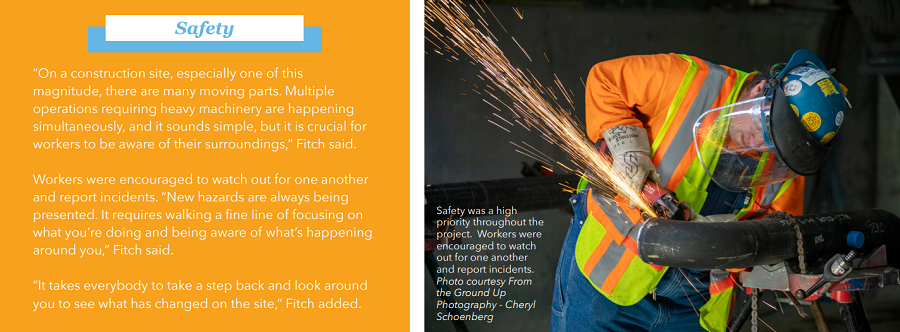Building KCI
Inclusive, intentional and transparent
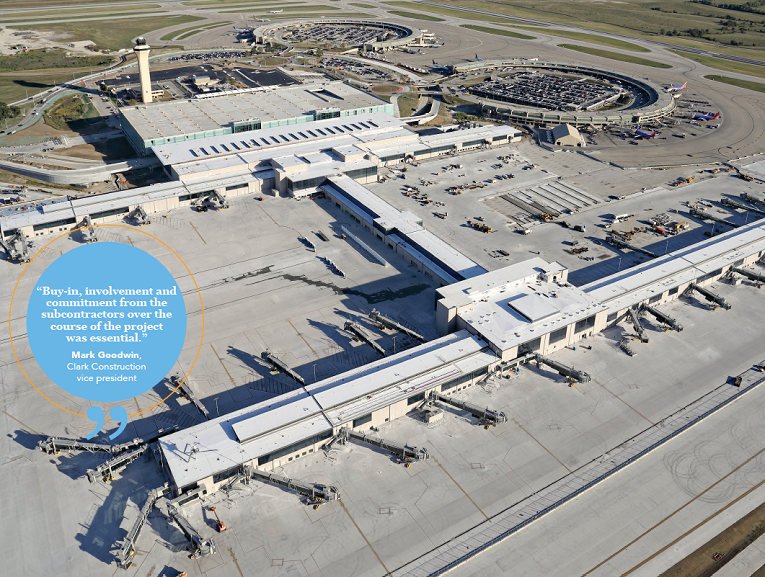 |
Above: An aerial view highlights the scale of the new terminal compared to the existing terminals (top of photo).
Photo courtesy of Dan Brownlee, Southwest Airlines. |
Originally opened in 1972, the three terminal Kansas City International Airport was once considered the forefront of aviation. The airport, known for being the height of airport convenience, had over the last few decades strayed further from the changing needs of travelers and aviation.
Several initiatives attempted to update the existing design, but Kansas City needed to leave behind the outdated terminals with few amenities and cramped accommodations, and instead, build something entirely new. The updated facility provides Kansas City the opportunity to host major upcoming events like the 2023 NFL Draft and 2026 World Cup.
PREPARING FOR TAKEOFF
In November 2017, Kansas City, Missouri voters approved construction of a single airport terminal with an overwhelming majority. In line with updated airport standards across the nation, the new single terminal needed to be constructed to meet the expectations of travelers and airlines coming in and out of Kansas City.
With voter approval, the construction of the new single terminal has become the largest public works project in Kansas City history. Before starting design, the Kansas City Aviation Department, Edgemoor Infrastructure & Real Estate, and Clark | Weitz | Clarkson, the team tasked with delivering the project, knew that the community needed to be heard.
“It took 18 months for us to establish a conceptual design that met the needs and desires of the aviation department and airlines,” said Mark Goodwin, Clark Construction vice president and project lead for the Clark | Weitz | Clarkson joint venture. “We did that along with a tremendous amount of community engagement. We’ve had over 20 individual outreach meetings to listen to what people wanted in this terminal, and what they liked and did not like about the existing facility. We took all that input into our design considerations.
From that outreach, we learned that convenience was a huge factor. Specifically, the convenience for parking,” Goodwin said. “We also learned that there was a lot of focus on inclusivity and accommodations. Different groups wanted to have an opportunity to support their constituents, so we listened and worked with them.”
AVOIDING TURBULENCE
In March 2019, Clark | Weitz | Clarkson moved out of the conceptual phase and began a 15-month design phase, as well as the start of breaking ground. Foundation work began in January 2020 and steel assembly began four months later in April 2020. With the COVID-19 pandemic slashing travel in 2020, the crews were able to fully erect the steel structure by the end of the year. At this point, Kansas Citians were able to see the 1 million-square-foot terminal come to life.
“One of the more technically challenging problems we had to solve was the number of building elements we had coming together at the same time,” Goodwin said. “The face of the new terminal and the face of the new parking garage, only separated by 50 feet and an elevated roadway, presented a huge challenge.”
The skin of the terminal at the lower arrivals level underneath the elevated roadway required 25-foot-tall precast panels. Those panels needed to be set with a crane but couldn’t be set after the other structural elements were in place. The panels had to be put in place first and temporarily shored, and then the structure was erected around them.
“We had to follow a creative sequence of activities. At one point, you could drive by and see the terminal facade standing alone,” Goodwin said. “A challenge like that required 10 to 15 building professionals to solve. We also relied on the expertise of our subcontractors to determine what was possible structurally and financially.”
Above left: Edgemoor and CWC prioritize diversifying not only the firms involved in the project but the labor force, as well. Photo courtesy From the Ground Up Photography - Cheryl Schoenberg
Above middle: Foundation work for the parking garage (foreground) occurred as the parking structure and terminal took shape in the background. Photo courtesy From the Ground Up Photography - Cheryl Schoenberg
Above right: M/W/DBE firms played a big role in the land package for the airport and helped develop the new roads for the terminal. Photo courtesy From the Ground Up Photography - Cheryl Schoenberg |
REACHING HIGH ALTITUDES
 For a project of this scale, every subcontractor had to be chosen carefully.
For a project of this scale, every subcontractor had to be chosen carefully.
“Buy-in, involvement and commitment from the subcontractors over the course of the project was essential,” said Goodwin.
The amenities the new terminal provides travelers are leaps and bounds ahead of the airport Kansas City has known over the last five decades. Inclusive restrooms and infant feeding rooms, service animal relief areas, military USO, business rooms, an inclusive play area, designated rideshare pickups, and even an air travel simulation room for nervous travelers will all be available to the public.
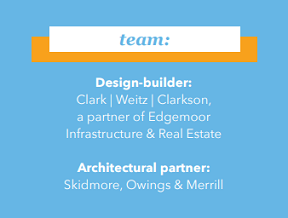 Inclusivity was paramount in consideration for travelers as well as for the subcontractors and workers involved. Edgemoor and Clark | Weitz | Clarkson made it a priority to encourage minority and women-owned firms to bid for packages on this project. The team also launched the Strategic Partnership Program to support small and diverse firms and put them in a position to participate in the terminal build while growing their portfolio of work.
Inclusivity was paramount in consideration for travelers as well as for the subcontractors and workers involved. Edgemoor and Clark | Weitz | Clarkson made it a priority to encourage minority and women-owned firms to bid for packages on this project. The team also launched the Strategic Partnership Program to support small and diverse firms and put them in a position to participate in the terminal build while growing their portfolio of work.
After graduating from the first class of the Strategic Partnership Program, Hartline Construction, LLC put the skills learned in the six-month, MBA-style program into action while competing for contracts on the KCI New Terminal Project. They were successful in those pursuits and awarded a safety carpentry package on the job.
During the SPP program, Hartline was encouraged to develop a mentor-protege partnership with an established company. Hartline reached out to E&K of Kansas City, Inc., to develop the mentoring relationship.
Upon completion of the new KCI Airport, Hartline will have installed 20% of the metal stud, drywall, acoustical ceiling tiles and wood ceilings on the project.
“Because of these two contracts, Hartline has developed relationships with other contractors in and outside Kansas City, allowing for continued networking,” said Jennifer Hart, president and owner of Hartline Construction. “Six months of the Strategic Partnership Program can elevate your business allowing for growth and continued success.”
Edgemoor Infrastructure & Real Estate also put into place Terminal Workforce Enhancement Programs, which includes a variety of programs to help M/W/DBE businesses gain access to the training, capital, cash flow, bonding support and even equipment needed to secure contracts.
Clarkson Construction Company formed a joint venture with Realm Construction Inc. to complete the package of work that included roads leading to and from the new terminal, the elevated roadway between the terminal and the parking garage, and associated bridges and retaining walls. To ensure a comprehensive approach, several minority and women-owned companies were subcontracted.
“We wanted as well-rounded of a team as possible to get this project to the finish line,” said Trevor Fitch, Clarkson chief project manager. “Firms of all sizes and experience levels were included, giving a wide variety of companies an opportunity to develop new skills while working on a project of this complexity. Firms within the general contractor and civil contractor community benefitted from having perspectives from the smaller firms involved, and likewise, those smaller firms were able to grow their business, as well.”
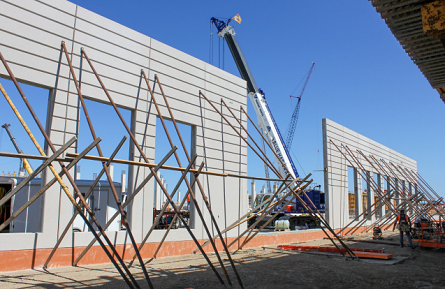 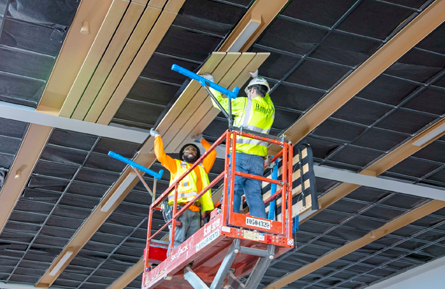 |
|
Left: The skin of the terminal at the lower arrivals level underneath the elevated roadway is made up of 25-foot-tall precast panels. Those panels needed to be set with a crane but couldn’t be set after the other structural elements were in place. The panels were put in place first and temporarily shored while the structure was erected around them.
Photo courtesy From the Ground Up Photography - Cheryl Schoenberg
Right: Upon completion of the new KCI Airport, Hartline will have installed 20% of the metal stud, drywall, acoustical ceiling tiles and wood ceilings on the project.
Photo courtesy Hartline Construction |
A SMOOTH LANDING INTO 2023
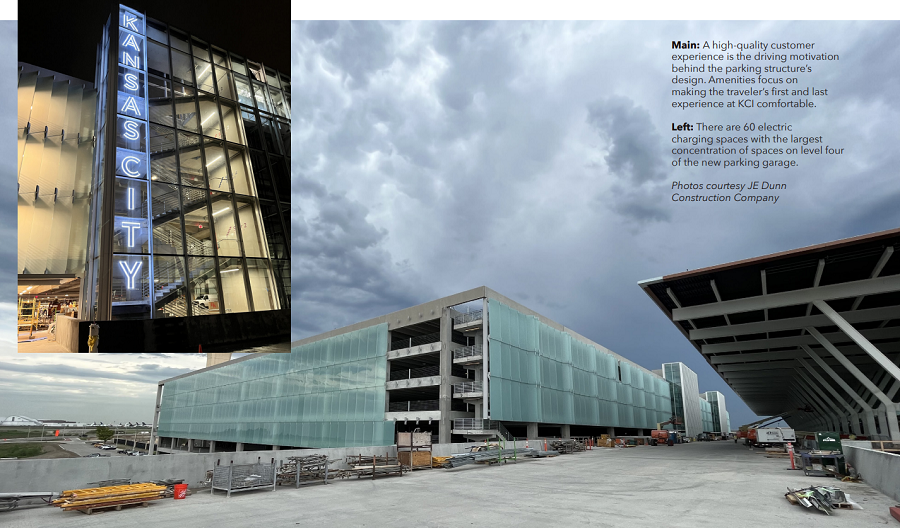
With such a high-profile project, Clark | Weitz | Clarkson made “Inclusive, Intentional and Transparent” their guiding principles, not just in sourcing firms and workers but also in their outreach and communication efforts with the public.
“I don’t think we’ve ever said no to an opportunity to speak with people who wanted to hear about the project,” Goodwin said.
Edgemoor and Clark | Weitz | Clarkson have engaged in over 500 interviews with different groups in the construction industry and local community. They made a personal commitment to making this the right terminal for Kansas City through their inclusive, intentional and transparent approach.
“This new airport terminal unlocks so many interesting and unique opportunities for Kansas City. Having world-class transit facilities and an exceptional first impression of our city will help us attract new businesses and jobs, new residents, and national and international level events, such as the NFL draft, the U.S. Conference of Mayors, and the FIFA World Cup in 2026,” Kansas City, Missouri City Manager Brian Platt said. “This terminal will be arguably the nicest airport and traveler experience in the entire United States when complete in a few short months.”
The new terminal is scheduled to open in March 2023 and will feature 39 gates, over 6,000 parking spaces, dedicated departure and arrival levels, concessions featuring 17 women and minority-owned businesses, electric charging stations, fountains and so much more, creating a positive travel experience for people locally, nationally and from all over the world.
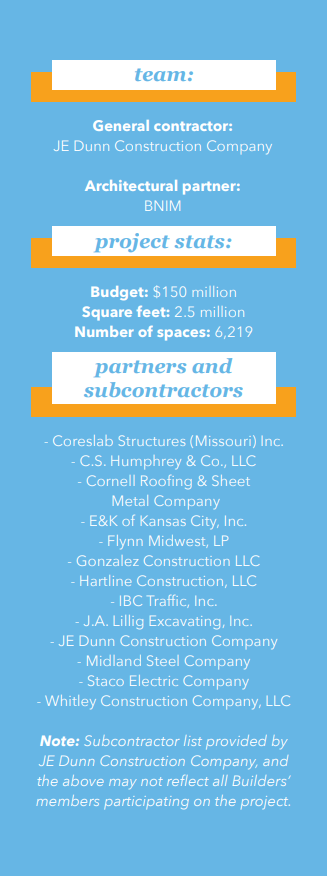 A WORLD-CLASS PARKING STRUCTURE FOR A WORLD-CLASS TERMINAL
A WORLD-CLASS PARKING STRUCTURE FOR A WORLD-CLASS TERMINAL
Edgemoor and Clark | Weitz | Clarkson enlisted the expertise of one of Kansas City’s own in the design-build of the state-of-the-art parking structure connected to the new terminal. JE Dunn was trusted not only by Edgemoor and the joint venture, but the Kansas City Aviation Department to bring a new parking structure that meets the level of design standard set by the new world-class terminal.
When it comes to KCI parking, JE Dunn is no stranger. Having built the parking garages for KCI’s Terminals A and C in 1989 and 1999, they came into the new terminal parking structure design bigger and better. With seven levels, 6,219 parking spots, 60 charging stations, parking guidance systems, bus induction chargers and dedicated commercial lanes, the new parking structure has gained a lot more without losing the convenience associated with the existing structures.
KCI’s parking capacity will increase by almost 50%, but the technological advancements of the structure have been a main focus.
“There is a parking guidance system that will monitor the individual parking stalls, meaning a sensor is illuminated with a color-coded system to identify if the stall is open, occupied, ADA accessible or EV charger capable,” said Mike Boyd, senior project manager for JE Dunn. “Customers will be able to find an open parking stall without driving down the aisles and searching. This should get them into a spot and inside the terminal more efficiently.”
Projects of this size and scale require new methods and materials to meet the needs of the client, their on-site craftworkers and the fluctuations in material costs. JE Dunn’s pre-build facility was meant just for that. “The JE Dunn pre-build facility engineered permanently cast-in-place bulkheads for the topping slab pours and the removable expansion joint blockouts,” said Boyd. “Using these allowed adjacent topping slab pours to occur on back-to-back days. The typical bulkhead, built out of dimensional lumber, needs to be wrecked out before the next pour. The labor savings were greater than the material cost increase for the installation and wrecking of these items.”
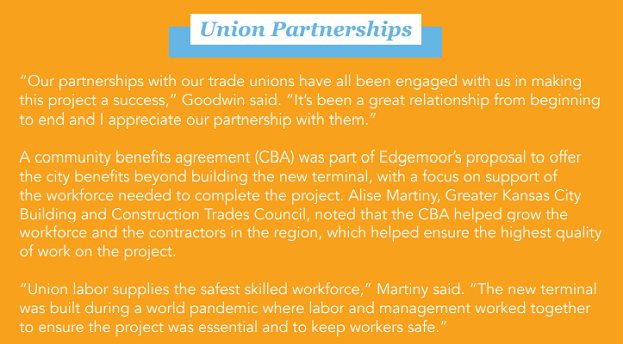
With Edgemoor and Clark | Weitz | Clarksons’ inclusive approach top of mind, JE Dunn conducted multiple interviews to make sure the diverse pool of firms sourced for the project were set up for success. Dividing traditional bid packages into smaller scopes so they were within reach of the bonding capacity or labor forces available to smaller contractors was a way for JE Dunn to put that inclusive approach into action.
“With Kansas City as our home, this project comes with a huge sense of civic pride and responsibility. We believe the new airport acts as the welcome mat for people from all over the world. Now the airport represents the awesome rise of amenities, culture and momentum felt around the city,” said Boyd.
